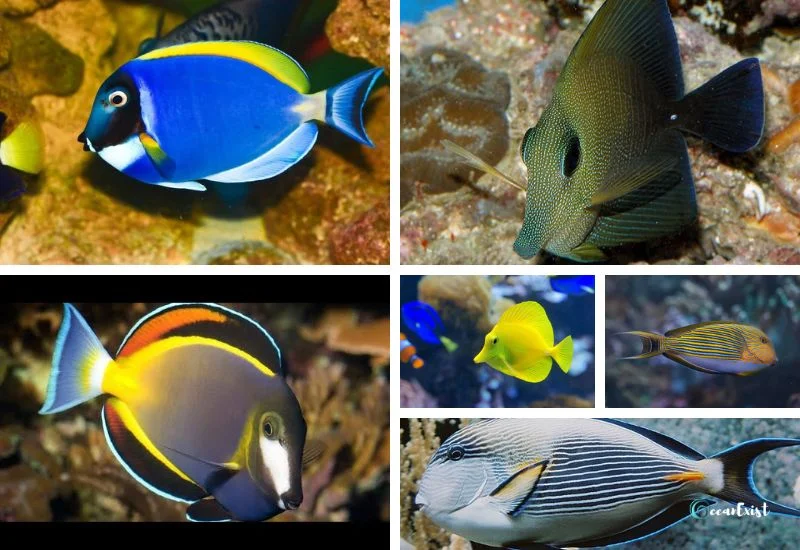Tangs are the most common and easy-to-recognize marine fish, only after clownfish. They come in over 80 types and species. And choosing from so many options to put in your aquarium is indeed a hard choice to make.
Known as surgeonfish, they have a striking appearance and mesmerizing look. However, having an aggressive nature, they are not for newbies. They require tropical tanks and intermediate care levels. All tangs are herbivores and prized for their algae-eating nature.
However, selecting the right tang fish for your aquarium requires deep knowledge and research. Here are the top 10 most popular types of tang fish species with pictures to guide you in selecting the best for your reef.
You will know these major traits for every tang fish type:
- Scientific Name
- Origin
- Size
- Color
- Diet
- Lifespan
- Care Level
- Tank Size
- Water temperature
- Water hardness
- Available As Tank Bred
So, why not dive in? Let’s go.
Yellow Tang
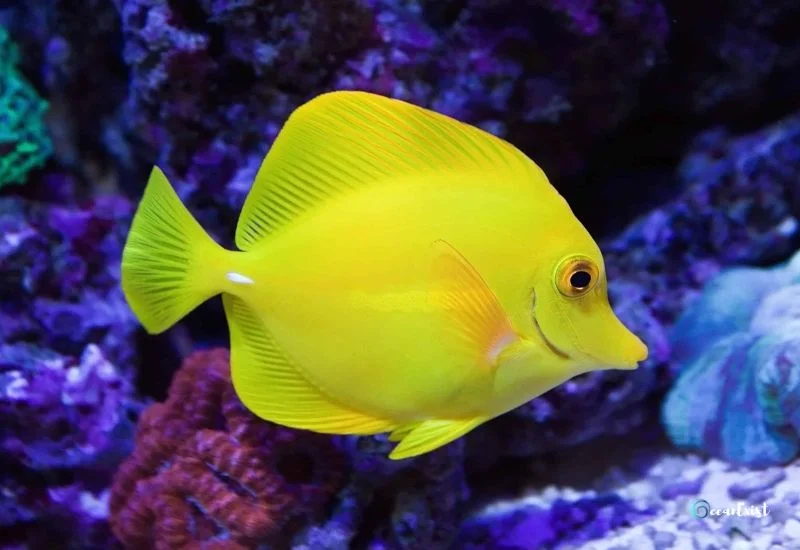
One of the most popular tang fish is the yellow Tang. They are small, hardy, and colorful. Being the most common, these surgeon fish can be found at any pet store.
But here is the deal. You cannot put a single yellow tang. They live in groups. And you have to buy it when they are young and all at once.
The good thing is that they are not susceptible to many marine diseases. Buying captive yellow Tang is beneficial because it is tamed and acclimated to several environmental changes.
Otherwise, they will become aggressive and under stress.
Here are the main specifications of Yellow Tang:
- Scientific Name: Zebrasoma flavescens
- Origin: Hawaii and Central Pacific
- Size: 8 inches (20 cm)
- Color: Bright yellow body with a prominent blue tail
- Diet: Herbivorous (eats algae primarily)
- Lifespan: 5-7 years
- Care Level: Moderate
- Tank Size: 75 gallons
- Water Temperature: 72-78°F (22-26°C)
- Water Hardness: 8-12 dKH
- Available As Tank Bred: Sometimes
Blue Tang
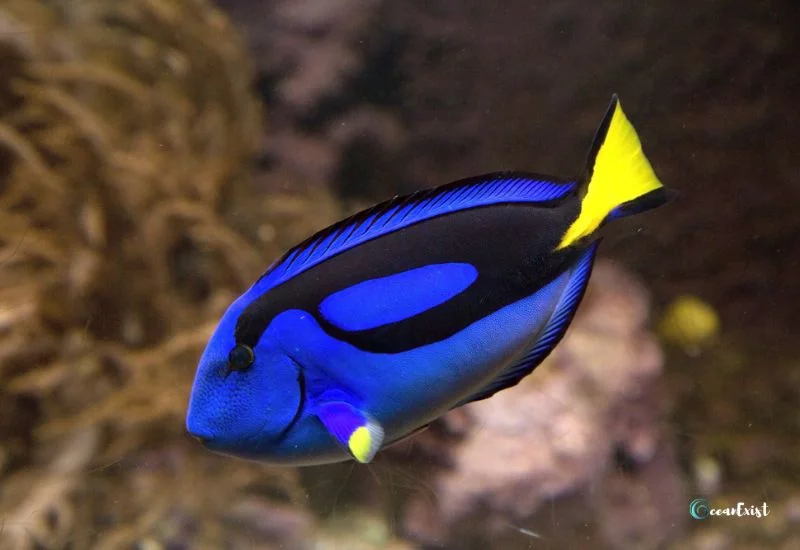
Blue Tangs are one of the most common types of tang fish. They have a vibrant and bold blue color with black markings on the body. Their tail and fin are yellow, adding a charm to their striking appearance.
The black line starts from the eyes and goes inline to their tails. Adding more charm to their appearance, their eyes are darker, whereas their bluish anal and dorsal fins end with black markings.
Being moderately aggressive, they require a moderate care level and thrive in big tanks of 180 gallons. Moreover, they are large in size. They grow up to 12 inches or 1 foot in length.
- Scientific Name: Paracanthurus hepatus
- Origin: Pacific Region
- Size: 12 inches (15 cm)
- Color: Royal blue body with a black design on the fin
- Diet: Herbivorous (algae, seaweed)
- Lifespan: 8-12 years
- Care Level: Moderate
- Tank Size: 180 gallons
- Water Temperature: 72-82°F (22-28°C)
- Water Hardness: 8-12 dKH
- Available As Tank Bred: Rarely
Naso Tang
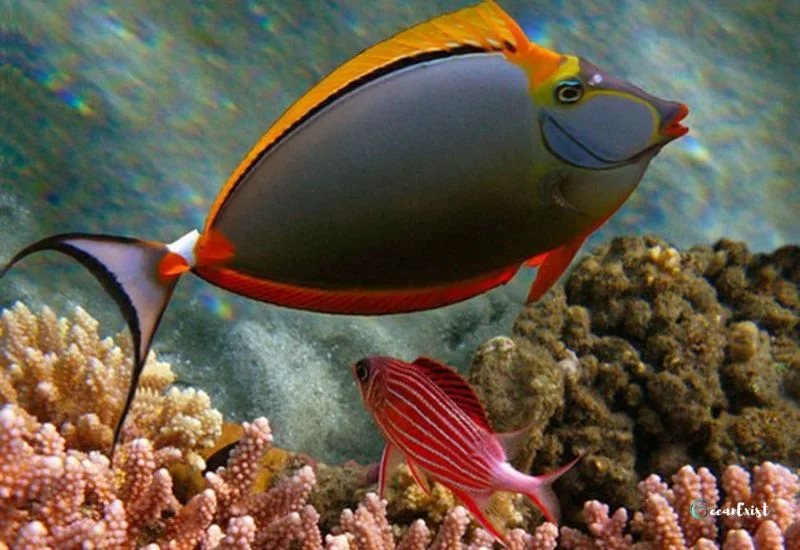
Naso tangs are the most sought-after tango fish by the aquarists. However, imports are limited for many aquarists. These lipstick fish are found in the Pacific.
Their appearance can be defined as grayish or darker colors with yellow markings, yellow or bright lips that look like lipstick, and darker fins with yellow patterns drawn over them.
They are large in size, at least 18 inches in length. Therefore, they require large tanks or more than 300 gallons. But, they are considered peaceful tango fish species and can be easily kept.
- Scientific Name: Naso spp. (Various species)
- Origin: Indo-Pacific region
- Size: 18 inches (45 cm)
- Color: grayish with various markings
- Diet: Herbivorous (algae, plankton)
- Lifespan: 10-15 years
- Care Level: Moderate to high
- Tank Size: 300 gallons
- Water Temperature: 72-80°F (22-27°C)
- Water Hardness: 8-12 dKH
- Available As Tank Bred: Rarely
Powder Blue Tang
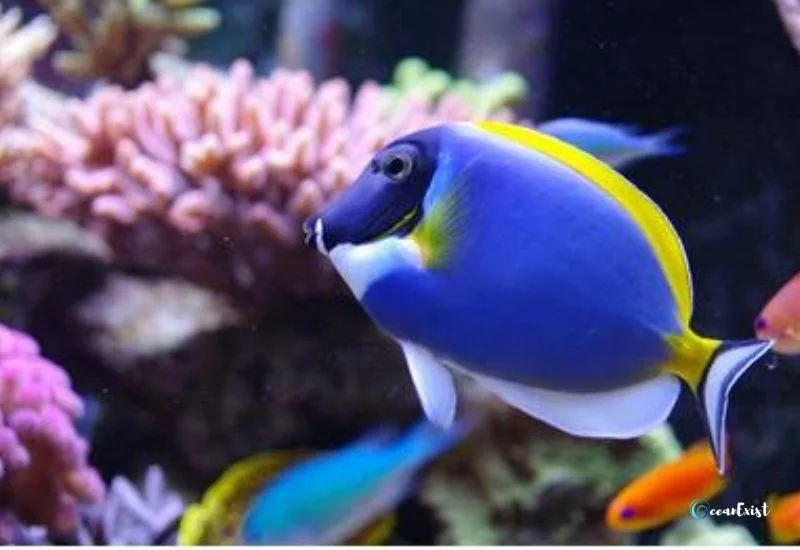
Powder blue tangs are striking in appearance and glamorous to watch. Unfortunately, they are one of the most sensitive tangs that do not sustain transport from a pet store to your aquarium.
These fish are fragile as compared to other tangs and are more prone to Ich and Velvet infection. These diseases take their lives easily, making them vulnerable to species.
When it comes to their coloration, their color is bluish but lighter than the blue tangs. Their dorsal and pectoral fins have a yellow pattern all over them, adding beautiful scenery.
Their anal and caudal fins are sky blue in color, making them rare tang species. Moreover, they grow up to 9 to 10 inches and thrive in a 125-gallon tank.
- Scientific Name: Acanthurus leucosternon
- Origin: Indo-Pacific region
- Size: 10 inches (25 cm)
- Color: Powder blue body with a yellow dorsal fin and caudal spine
- Diet: Herbivorous (algae, seaweed)
- Lifespan: 5-7 years
- Care Level: Moderate
- Tank Size: 125 gallons
- Water Temperature: 72-82°F (22-28°C)
- Water Hardness: 8-12 dKH
- Available As Tank Bred: Rarely
Purple Tang
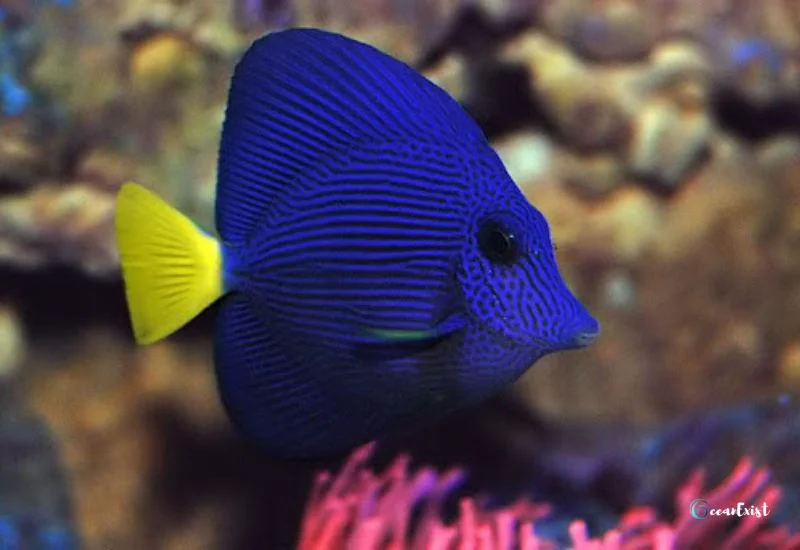
One of the pricer and unique tang fish. Purple Tang is a saltwater tang. They are found in the Red Sea, but some of their species are found in the Indian Ocean. As their name suggests, they have deep purple bodies with yellow tail fins.
They are medium-sized compared to other tangs and can be inhabited in the tanks, making them the top choice among aquarists. They thrive in 100-gallon tanks and like 72-78°F water temperature.
Purple tangs are found in groups or schools, but they sometimes show intolerant behavior toward other species and to the same species. They eat algae, which is why they are called clean crews and loved by the aquarists to clean their reefs.
- Scientific Name: Zebrasoma Xanthurum
- Origin: Red Sea
- Size: 8 inches (20 cm)
- Color: Deep purple body with a yellow tail fin
- Diet: Herbivorous (algae)
- Lifespan: 5-10 years
- Care Level: Moderate to high
- Tank Size: 100 gallons
- Water Temperature: 72-78°F (22-26°C)
- Water Hardness: 8-12 dKH
- Available As Tank Bred: Easily
Chevron Tang
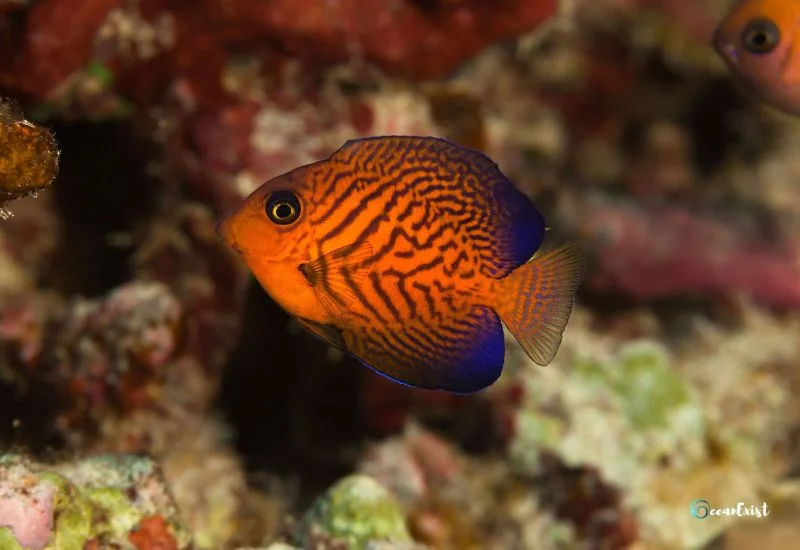
Chevron tang, scientifically known as Crotenochaetus hawaiiensis, is a rare tang species. They live across Hawaii, and most of the time, they thrive in deep waters ranging from 200 feet to deeper waters.
Their appearance changes from their juvenile to old age. Juveniles Chevron tang have lighter appearance, helping them camouflage. On the other hand, old or mature Chevron has darker colors. They have brown colors and v-type patterns all over the body.
They live up to 5 to 7 years, and you can put them in a 75-gallon tank. Their length is smaller than that of other tangs.
- Scientific Name: Crotenochaetus hawaiiensis
- Origin: Hawaii
- Size: 6 inches (15 cm)
- Color: Yellow-orange body with darker chevron markings
- Diet: Herbivorous (algae)
- Lifespan: 5-7 years
- Care Level: Moderate
- Tank Size: 75 gallons
- Water Temperature: 72-78°F (22-26°C)
- Water Hardness: 8-12 dKH
- Available As Tank Bred: Rarely
Kole Tang
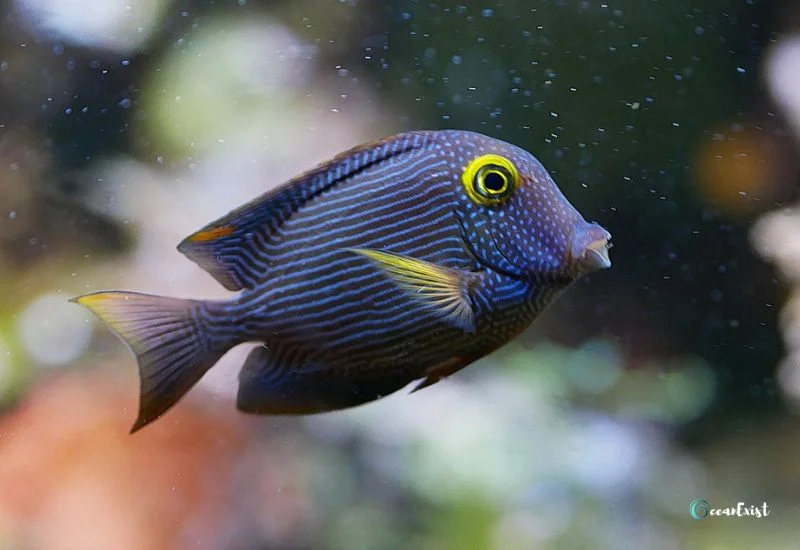
Kole Tang, Bristletooth Tang, or Yellow-Eyed Tang are found around the Philippines and the Hawaiian Islands.
They are much smaller than other tangs and show peaceful behavior. They grow up to 7 inches and have grayish-brown bodies with yellow accents.
Their favorite food is algae, and they show moderate care levels. You can put them in a 75-gallon tank, and they will live happily.
- Scientific Name: Ctenochaetus strigosus
- Origin: Hawaiian Islands and Indo-Pacific region
- Size: 7 inches (18 cm)
- Color: Grayish-brown body with yellow accents
- Diet: Herbivorous (algae)
- Lifespan: 5-10 years
- Care Level: Easy to moderate
- Tank Size: 75 gallons for one Tang
- Water Temperature: 72-78°F (22-26°C)
- Water Hardness: 8-12 dKH
- Available As Tank Bred: Yes
Convict Tang
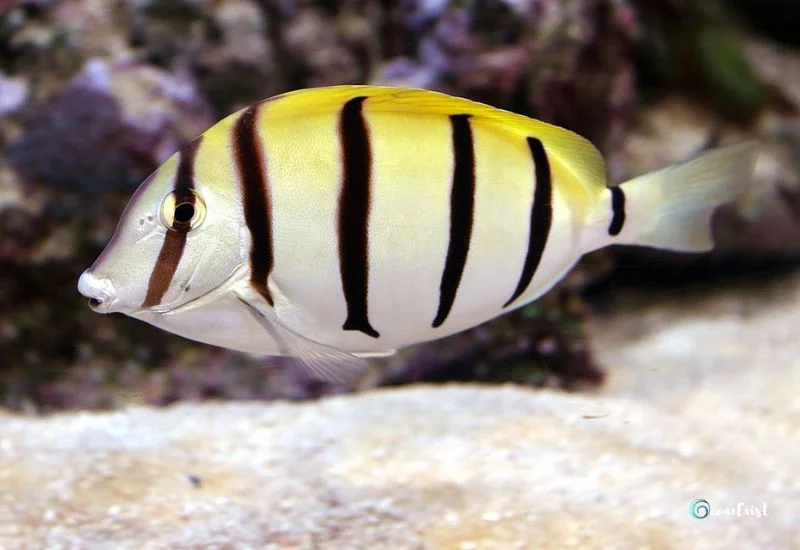
Convict tang, also known as Convict Surgeonfish, is white with vertical black bars. They are found in the Indo-Pacific region.
These fish are more aggressive, and when put with other fish, they can harass them. But, if all the other Convict fish are put at the same time, they will live peacefully and make friends.
Breeding them in the tanks is almost impossible. It is because they live more time in the planktonic stage and due to the constant fear of sucking through water filters.
For the hobby, you can put them in a 125-gallon tank, where the temperature should be between 72 and 78F and water hardness between 8 to 12 dKH.
- Scientific Name: Acanthurus triostegus
- Origin: Indo-Pacific region
- Size: 8 inches (20 cm)
- Color: White-Yellowish body with thin vertical black stripes
- Diet: Herbivorous (algae)
- Lifespan: 5-10 years
- Care Level: Moderate
- Tank Size: 125 gallons
- Water Temperature: 72-78°F (22-26°C)
- Water Hardness: 8-12 dKH
- Available As Tank Bred: Hard
Powder Brown Tang
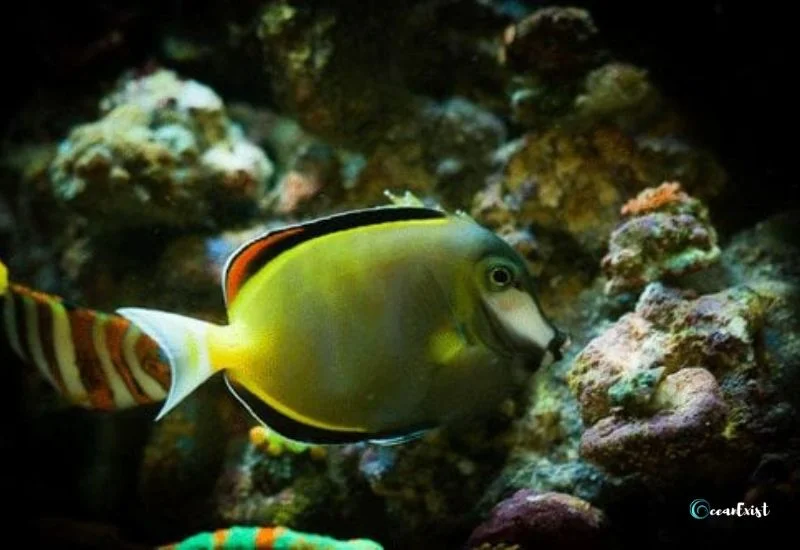
Powder Brown Tang, with the scientific name Acanthurus japonicus, is found in warm waters near Taiwan and Japan.
These surgeonfish swim in groups under 25 feet of water. They are put in the category of semi-aggressive tang fish and grow up to 8 inches.
They are herbivorous and eat algae. Aquarists put them on due to their pro-cleaning habits. But to keep them, the tank should be 125 gallons and temperature at 78F.
As their name suggests, they are brown in color with white smudge all over their body. Their dorsal and anal fins have different patterns. Starting from yellow to black and ending with white colors. Mature powder brown tangs have reddish patterns at the end of their fins.
- Scientific Name: Acanthurus japonicus
- Origin: Indo-Pacific region
- Size: 8 inches (20 cm)
- Color: Brown body with a white or yellow tail
- Diet: Herbivorous (algae)
- Lifespan: 5-7 years
- Care Level: Moderate
- Tank Size: 125 gallons
- Water Temperature: 72-78°F (22-26°C)
- Water Hardness: 8-12 dKH
- Available As Tank Bred: Not So Much
Orange Shoulder Tang
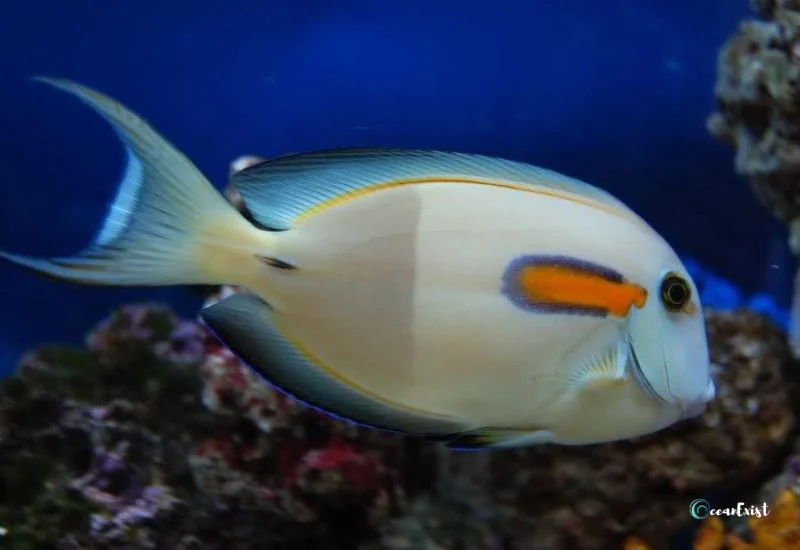
Orange shoulder tang is the common Tang that is found across the Hawaiian Islands. Their scientific name is Acanthuru Olivaceus, but they are commonly known as Orange-epaulette Surgeonfish, Orangespot Surgeonfish, Orangeband Surgeonfish, and Orange Shoulder Surgeonfish.
These fish are hardy as compared to other tangs. However, they are easily frightened, which is why they live under covers. Therefore, put them in 125-gallon tanks that should be full of plants and rocks where you can mimic their habitat.
When it comes to their appearance, juvenile Orange shoulder tangs have a lighter color tone. As they grow to adulthood, their colors become stronger, and orange shoulders become stronger and easy to notice.
- Scientific Name: Acanthurus olivaceus
- Origin: Indo-Pacific region
- Size: 10 inches (25 cm)
- Color: Brown body with an orange shoulder patch
- Diet: Herbivorous (algae)
- Lifespan: 5-10 years
- Care Level: Moderate
- Tank Size: 125 gallons
- Water Temperature: 72-78°F (22-26°C)
- Water Hardness: 8-12 dKH
- Available As Tank Bred: Yes
Conclusion
Now you know all about different types of tang fish. They are hard to keep for newbies, require much care, and live in large or tropical tanks.
Along with this, water parameters and their diet should be kept in mind. Otherwise, you can stress your tang fish, and they might die.
It was all from my side. I hope you pick up all the information I shared. If you have any comments or suggestions to add, please comment below.
Let’s proceed to our new research on betta fish types.
